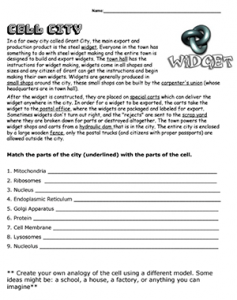
This popular activity asks students to read a story about a fictional town where each part of the city is compared to the parts of a cell. For example: “Widgets are generally produced in small shops around the city, these small shops can be built by the carpenter’s union (whose headquarters are in town hall.)” In this case, the small shops represent ribosomes which make proteins, or the widgets.
The small shops are in turn made by the carpenter’s union, which would be the nucleolus. Students of all ages can make these comparisons, though some may need more guidance than others. For many students, this helps them learn the part of the cell because they can equate each organelle to the job that it does.
A final task asks students to imagine another analogy that would compare to a cell. Students can draw these on paper or describe them to the class.
Grade Level: 6-12
Time Required: 15-25 minutes
HS-LS1-2 Develop and use a model to illustrate the hierarchical organization of interacting systems that provide specific functions within multicellular organisms

